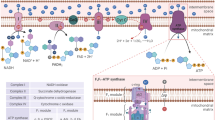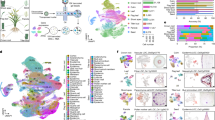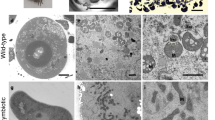Abstract
IN rice coleoptile cells mitochondria can be formed and preserved without any notable signs of destruction in the absence of molecular oxygen1,3. In this, rice coleoptiles are strikingly different from other plant tissues, whose fine cell organisation is degraded during even a short-term anaerobiosis4–6. In the experiments mentioned, however1–3, the rice seeds were grown from the very beginning under oxygen-free conditions. This excluded not only the possibility of functioning of mitochondria but, probably also, their normal formation. One could therefore suppose that such mitochondria as yeast promitochondria7,8 do not contain all the carriers of the respiratory chain and possess an enhanced resistance to anaerobiosis. High resistance of cell ultrastucture to anoxia could be, on the other hand, secured by intensive energy output through glycolysis.
This is a preview of subscription content, access via your institution
Access options
Subscribe to this journal
Receive 51 print issues and online access
$199.00 per year
only $3.90 per issue
Buy this article
- Purchase on SpringerLink
- Instant access to full article PDF
Prices may be subject to local taxes which are calculated during checkout
Similar content being viewed by others
Change history
01 July 1974
IN the letter "Appearance of unusual mitochondria in rice coleoptiles at conditions of secondary anoxia" by B. B. Vartapetian, I. N. Andreeva and A. L. Kursanov (Nature, 248, 258; 1974) the wrong illustration was published as Fig. Id. The bottom half of Fig. 1 should be: Fig. 1 Ultrastructure of mitochondria in cells of rice roots and coleoptiles in aerobic and anaerobic conditions, a, Root, 9 d after growth in aerobic conditions; b, root, 6 d of aerobic growth, then 3 d of growth in anaerobic conditions; c, colooptile, 9 d of aerobic growth; d, coleoptile, 6 d of aerobic growth, then 5 d of growth in anaerobic conditions.
References
Vartapetian, B. B., Andreeva, I. N., and Maslova, I. P., Dokl. Akad. Nauk S.S.S.R., 196, 1231 (1971).
Ueda, K., and Tsuji, H., Protoplasma, 73, 203 (1971).
Vartapetian, B. B., Maslova, I. P., and Andreeva, I. N., Fiziol. Rast., 19, 106 (1972).
Kursanov, A. L., and Vartapetian, B. B., Mediterranea, 27, 726 (1968).
Vartapetian, B. B., Andreeva, I. N., Maslova, I. P., and Davtian, N. G., Agrochimica, 15, 1 (1970).
Vartapetian, B. B., Andreeva, I. N., and Maslova, I. P., Fiziol. Rast., 19, 1105 (1972).
Watson, K., Haslam, J. M., and Linnane, A. W. I., J. Cell Biol., 46, 88 (1970).
Schatz, G., in Membranes of Mitochondria and Chloroplasts (edit. by Racker, E.), 257 (New York, 1970).
Karnovsky, M. I., J. Cell Biol., 27, 137A (1968).
Bonner, W. D., in Plant Biochemistry (edit. by Bonner, J., and Varner, J. E.), 89 (Academic, New York, 1965).
Novikoff, A. B., The Cell, 2, 299 (1961).
Author information
Authors and Affiliations
Rights and permissions
About this article
Cite this article
VARTAPETIAN, B., ANDREEVA, I. & KURSANOV, A. Appearance of Unusual Mitochrondria in Rice Coleoptiles at Conditions of Secondary Anoxia. Nature 248, 258–259 (1974). https://doi.org/10.1038/248258a0
Received:
Issue date:
DOI: https://doi.org/10.1038/248258a0
This article is cited by
-
Plant Anaerobic Stress as a Novel Trend in Ecological Physiology, Biochemistry, and Molecular Biology: 1. Establishment of a New Scientific Discipline
Russian Journal of Plant Physiology (2005)
-
On the Physiological Role of Anaerobically Synthesized Lipids in Oryza sativa Seedlings
Russian Journal of Plant Physiology (2005)
-
Protective effect of exogenous nitrate on the mitochondrial ultrastructure ofOryza sativa coleoptiles under strict anoxia
Protoplasma (1999)
-
Pasteur effect visualization by electron microscopy
Naturwissenschaften (1982)
-
Biological method for fine purification of nitrogen and inert gases from O2 traces
Naturwissenschaften (1981)



